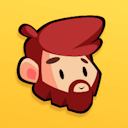Top Down Movement - Module Overview
Game Jam
- Handle 8-way movement in a top-down game.
- Create walls and obstacles for the player to avoid.
- Use assets provided by an artist.
- Pause the game.
- Restart the game when winning or losing.
- Code an AI-controlled character that pursues the player and avoids nearby obstacles.
- Character controller: Implement a relatively advanced top-down controller for your character, with acceleration and deceleration.
- Obstacles: Learn how to create obstacles for your character to avoid with the StaticBody2D node. The CharacterBody2D, Area2D, and StaticBody2D nodes cover the needs of most games when it comes to 2D movement and detecting interactions. You can code all sorts of game characters with these three nodes.
- Using people's assets: Learn how to use the assets provided by the artist in your team, read their provided documentation, and adapt them to your game.
- Particles: Add particles to your game. Particles are everywhere in games, from dust to fire to explosions, you can't really escape using them. They're also very fun!
- Cutscene basics: You will learn to take control away from the player and move the character yourself in code, which is the foundation for making cutscenes.
- Game states: Implement a countdown before the game starts, a pause system, and a winning condition that restarts the game.
We ramped up the difficulty a notch
Thinking in code
Reading code is one of the most foundational skills of any good game developer. Once the code makes sense as you read it, you can learn from any code example in the wild. It allows you to look up references and keep learning even when no documentation or articles explain something you want to achieve.
Provided scenes
Nathan
Founder and teacher at GDQuest
- An animated sprite of a runner that can rotate in all directions.
- An outline shader to draw an outline around the runner.
- A finish line that triggers the end of the game and spawns confetti when the player walks on it.
- A big countdown that counts from 3 to 0 before the game starts.
- A blur shader that blurs the game when the player pauses the game.


Lesson Q&A
Use this space for questions related to what you're learning. For any other type of support (website, learning platform, payments, etc...) please get in touch using the contact form.